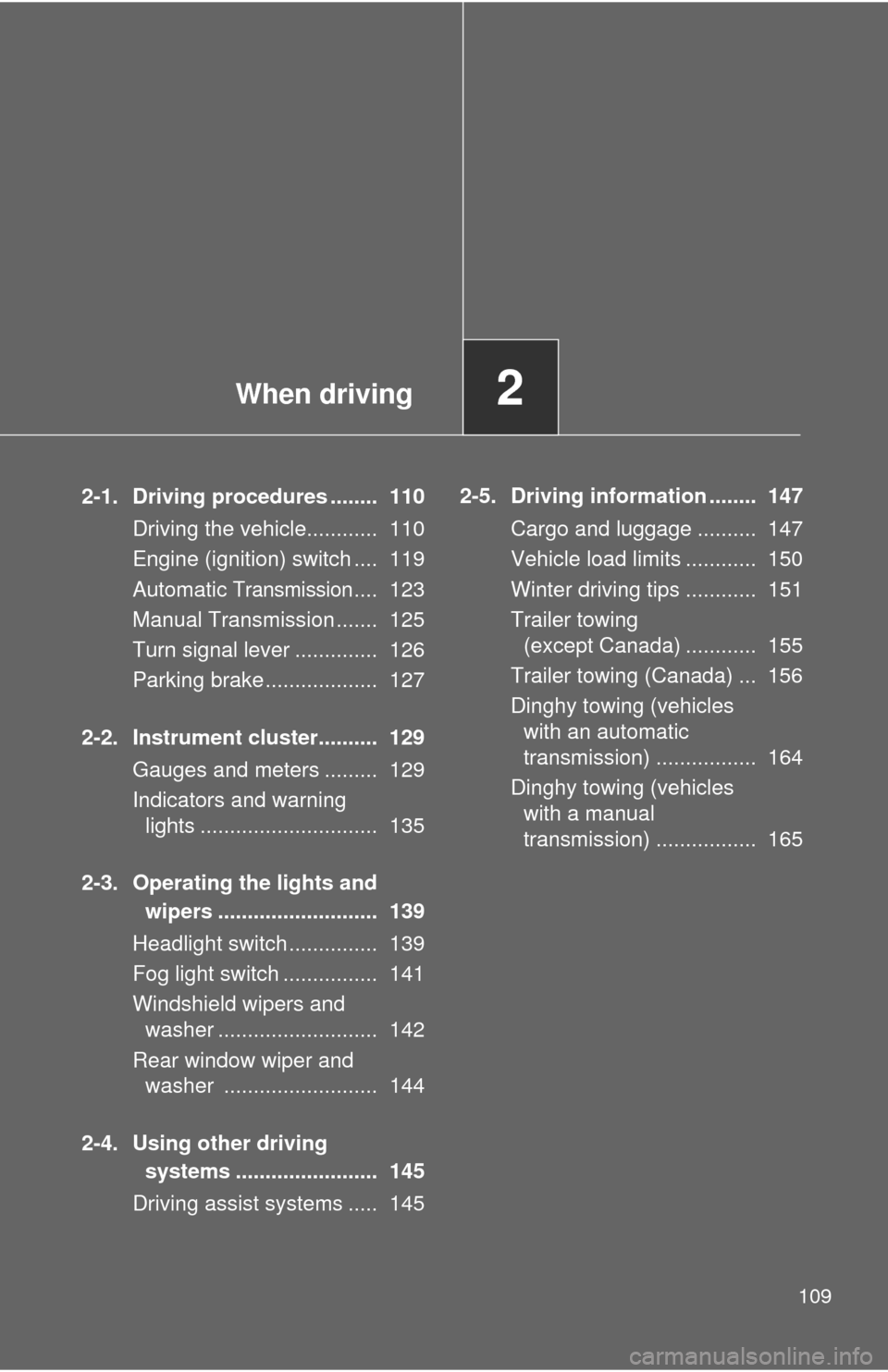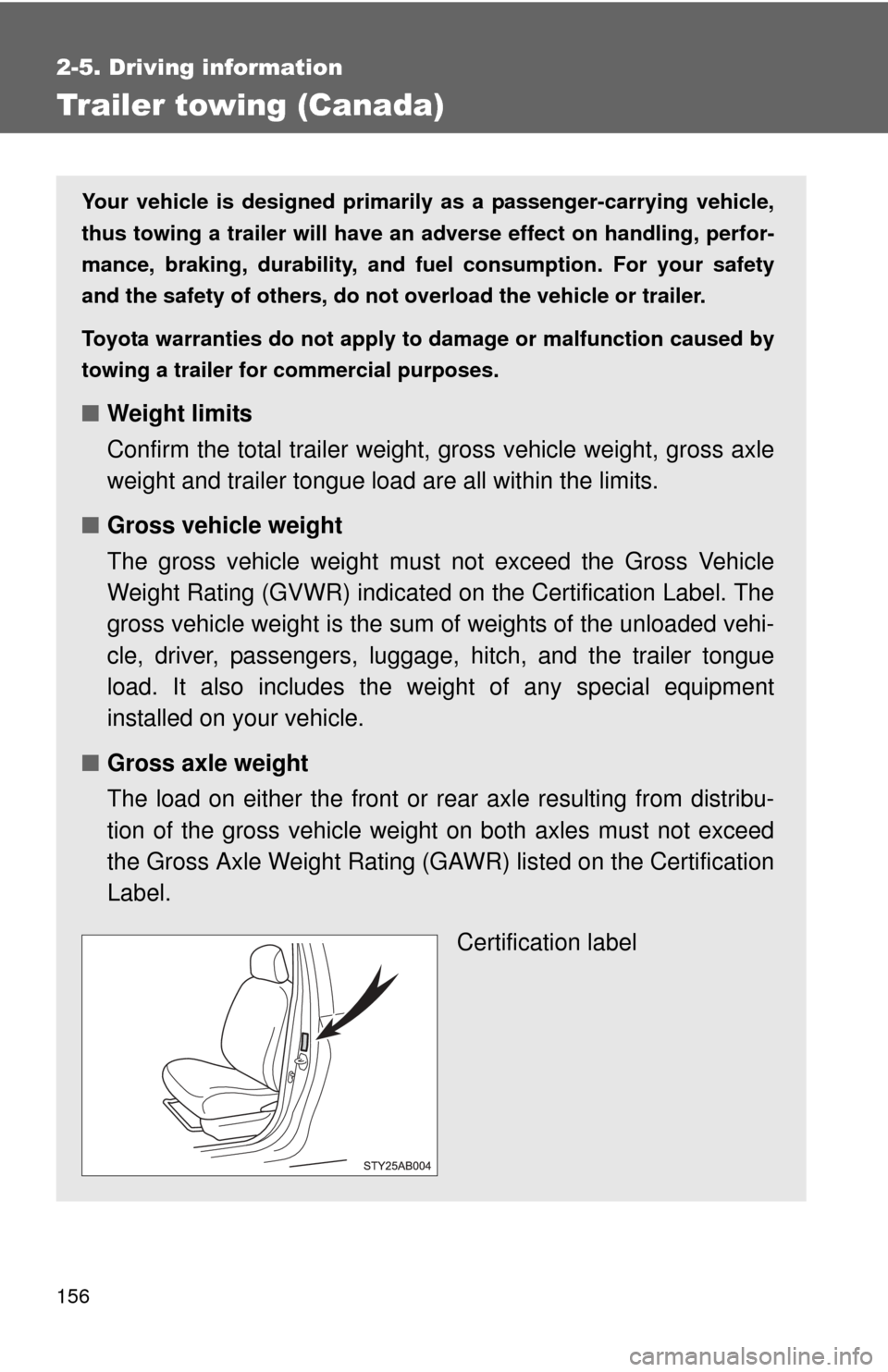Page 3 of 388

1
2
3
4
5
6
7
3
2-5. Driving information ........... 147Cargo and luggage ............. 147
Vehicle load limits ............... 150
Winter driving tips ............... 151
Trailer towing (except Canada) ............... 155
Trailer towing (Canada) ...... 156
Dinghy towing (vehicles with an automatic
transmission) .................... 164
Dinghy towing (vehicles with a manual
transmission) .................... 165
3-1. Using the air conditioning system and defogger...... 168
Air conditioning system ....... 168
Rear window defogger ........ 175
3-2. Using the audio system.... 176 Audio system types ............. 176
Using the radio .................... 179
Using the cassette player.... 182
Using the CD player ............ 185
Playing back MP3 and WMA discs ........................ 192
Optimal use of the audio system .............................. 200
Using the AUX adapter ....... 203
3-3. Using the interior lights.... 204 Interior lights list .................. 204
• Interior light .......................205
• Personal lights ...................205 3-4. Using the storage
features ........................... 206
List of storage features ....... 206
• Glove boxes ..................... 206
• Cup holders ...................... 208
• Bottle holders ................... 209
• Auxiliary boxes ................. 211
3-5. Other interior features ..... 213 Sun visors........................... 213
Vanity mirrors ..................... 214
Clock .................................. 215
Power outlet ....................... 217
Floor mat ............................ 218
Luggage compartment features ............................ 219
4-1. Maintenance and care ...... 222 Cleaning and protecting the vehicle exterior ................. 222
Cleaning and protecting the vehicle interior .................. 224
4-2. Maintenance...................... 227 Maintenance requirements .................... 227
General maintenance ......... 229
Emission inspection and maintenance (I/M)
programs .......................... 232
3Interior features
4Maintenance and care
Page 109 of 388

When driving2
109
2-1. Driving procedures ........ 110Driving the vehicle............ 110
Engine (ignition) switch .... 119
Automatic
Transmission.... 123
Manual Transmission ....... 125
Turn signal lever .............. 126
Parking brake ................... 127
2-2. Instrument cluster.......... 129 Gauges and meters ......... 129
Indicators and warning lights .............................. 135
2-3. Operating the lights and wipers ........................... 139
Headlight switch ............... 139
Fog light switch ................ 141
Windshield wipers and washer ........................... 142
Rear window wiper and washer .......................... 144
2-4. Using other driving systems ........................ 145
Driving assist systems ..... 145 2-5. Driving information ........ 147
Cargo and luggage .......... 147
Vehicle load limits ............ 150
Winter driving tips ............ 151
Trailer towing (except Canada) ............ 155
Trailer towing (Canada) ... 156
Dinghy towing (vehicles with an automatic
transmission) ................. 164
Dinghy towing (vehicles with a manual
transmission) ................. 165
Page 112 of 388

112 2-1. Driving procedures
Lightly depress the accelerator pedal at the same time as
gradually releasing the clutch pedal.
Release the parking brake.
■Driving in the rain
●Drive carefully when it is raining, because visibility will be reduced, the
windows may become fogged-up, and the road will be slippery.
● Drive carefully when it starts to rain, because the road surface will be
especially slippery.
● Refrain from high speeds when driving on an expressway in the rain,
because there may be a layer of water between the tires and the road
surface, preventing the steering and brakes from operating properly.
■ Breaking in your new Toyota
To extend the life of the vehicle, the following precautions are recommended
to observe:
●For the first 200 miles (300 km):
Avoid sudden stops.
● For the first 500 miles (800 km):
Do not tow a trailer.
● For the first 1000 miles (1600 km):
• Do not drive at extremely high speeds.
• Avoid sudden acceleration.
• Do not drive continuously in the low gears.
• Do not drive at a constant speed for extended periods.
■ Operating your vehicle in a foreign country
Comply with the relevant vehicle registration laws and confirm the availability
of the correct fuel. ( P. 340)
■ Normal characteristics afte r turning off the engine
Approximately five hours after the engine is turned off, you may hear sound
coming from under the vehicle for several minutes. This is the sound of a
fuel evaporation leakage check and, it does not indicate a malfunction.
Page 148 of 388

148 2-5. Driving information
(6) If your vehicle will be towing a trailer, load from your trailer will be
transferred to your vehicle. Consult this manual to determine how
this reduces the available cargo and luggage load capacity of your
vehicle.
Except Canada:
Toyota does not recommend towing a trailer with your vehicle. Your
vehicle is not designed for trailer towing.
Example on your vehicle
Cargo capacity
Total load capacity
When 2 people with the combined weight of 366 lb. (166 kg) are
riding in your vehicle, which has a total load capacity of 845 lb. (383
kg), the available amount of cargo and luggage load capacity will be
as follows:
845 lb. 366 lb. = 479 lb. (383 kg 166 kg = 217 kg)
In this condition, if 3 more pa ssengers with the combined weight of
388 lb. (176 kg) get on , the available cargo and luggage load will be
reduced as follows:
479 lb. 388 lb. = 91 lb. (217 kg 176 kg = 41 kg)
As shown in the above example, if the number of occupants
increases, the cargo and luggage load will be reduced by an amount
that equals the increased weight du e to the additional occupants. In
other words, if an increase in the number of occupants causes an
excess of the total load capacity (combined weight of occupants plus
cargo and luggage load), you must reduce the cargo and luggage on
your vehicle.
Page 150 of 388

150
2-5. Driving information
Vehicle load limits
■Total load capacity and seating capacity
These details are also described on the tire and loading information
label.(P. 258)
CAUTION
■Overloading the vehicle
Do not overload the vehicle.
It may not only cause damage to the ti res, but also degrade steering and
braking ability, resulting in an accident.
Vehicle load limits include total load capacity, seating capacity,
towing capacity and cargo capacity.
■ Total load capacity: 845 lb. (383 kg)
Total load capacity means the combined weight of occupants,
cargo and luggage.
■ Seating capacity: 5 occupants (Front 2, Rear 3)
Seating capacity means the ma ximum number of occupants
whose estimated average weight is 150 lb. (68 kg) per person.
Even if the number of occupants are within the seating capacity,
do not exceed the total load capacity.
■ Towing capacity (Canada): 700 lb. (318 kg)
Towing capacity means the maximum gross trailer weight (trailer
weight plus its cargo weight) that your vehicle is able to tow.
■ Towing capacity (except Canada)
Toyota does not recommend towing a trailer with your vehicle.
■ Cargo capacity
Cargo capacity may increase or decrease depending on the
weight and the number of occupants.
Page 155 of 388
155
2-5. Driving information
2
When driving
Trailer towing (except Canada)
Toyota does not recommend towing a trailer with your vehicle. Toy-
ota also does not recommend the installation of a tow hitch or the
use of a tow hitch carrier of a wheelchair, scooter, bicycle, etc. Your
Toyota is not designed for trailer towing or for the use of tow hitch
mounted carriers.
Page 156 of 388

156
2-5. Driving information
Trailer towing (Canada)
Your vehicle is designed primarily as a passenger-carrying vehicle,
thus towing a trailer will have an ad verse effect on handling, perfor-
mance, braking, durability, and fu el consumption. For your safety
and the safety of others , do not overload the vehicle or trailer.
Toyota warranties do not apply to damage or malfunction caused by
towing a trailer for commercial purposes.
■ Weight limits
Confirm the total trailer weight, gross vehicle weight, gross axle
weight and trailer tongue load are all within the limits.
■ Gross vehicle weight
The gross vehicle weight must not exceed the Gross Vehicle
Weight Rating (GVWR) indicated on the Certification Label. The
gross vehicle weight is the sum of weights of the unloaded vehi-
cle, driver, passengers, luggage, hitch, and the trailer tongue
load. It also includes the we ight of any special equipment
installed on your vehicle.
■ Gross axle weight
The load on either the front or rear axle resulting from distribu-
tion of the gross vehicle weight on both axles must not exceed
the Gross Axle Weight Rating (GAWR) listed on the Certification
Label.
Certification label
Page 157 of 388
157
2-5. Driving information
2
When driving
■
Trailer tongue load
The trailer cargo load should be distributed so that the tongue
load is 9 to 11% of the total trailer weight, not exceeding the
maximum 70 lb. (32 kg) (Tongue load / Total trailer weight 100
= 9 to 11%)
The total trailer weight and tongue load can be measured with
platform scales found at a highway weighing station, building
supply company, trucking company, junk yard, etc.
Total trailer weight
Tongue load